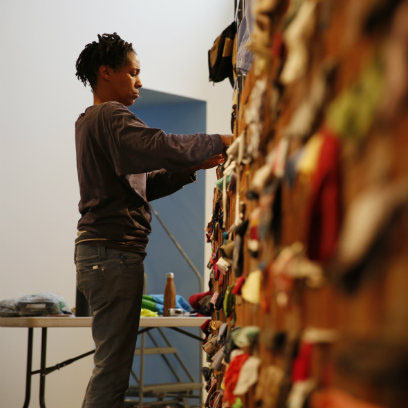“Often the assumption with Black and Brown artists is that we’re going to present a physical representation of what Blackness or Brownness, or identity, is,” Karyn Olivier told Bomb this April. “So when we don’t, it thwarts those expectations.” Born in Trinidad and Tobago and raised in New York, Olivier mainly makes installations—several are prominent public works—and elegant sculptures that are primarily non-representational but nonetheless haunted by the figurative.

Upon entering her current solo show, at Tanya Bonakdar Gallery, one encounters Fortified, an imposing wall—12 feet high and 20 feet in length—made from steel and brick. Undercutting its stability, however, are colorful socks, sleeves, scarves, gloves, T-shirts, and shoestrings, which thread across the wall, between the bricks, in lieu of cement. These traces of teeming life invite viewers to ask what exists on the other side of this otherwise impassable piece.
“My hope is that it allows for a heightened empathy,” Olivier told Bomb. The absences in her work, she continued, imply “violence and the individual narratives lost in the hierarchies of what is deemed important and not.” Olivier places great trust in the power of objects to insinuate meaning, in part because she believes in the inherent mutability of things: “A brick could build a wall or it could be a weapon if need be.”

Other works on view at Tanya Bonakdar are more blatantly political. In the back of the gallery, past the massive brick-and-fiber wall, is a piece called Falsehood (Cape). A hoodie hung on a coatrack, the silhouette vague, it’s an apparition that recalls Trayvon Martin and countless other boys who looked like him and died like him.
There is a person-shaped hole at the heart of much of Olivier’s art, voids that do not simply serve as remembrances but that ask us to keep our ghosts close at hand, and to topple brick walls rather than bypass them. —Clementine Ford


 Discover
Discover